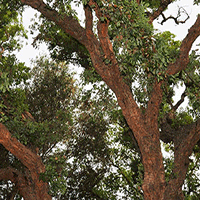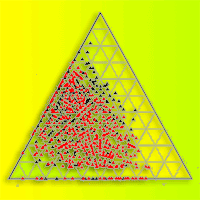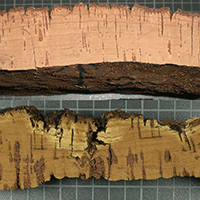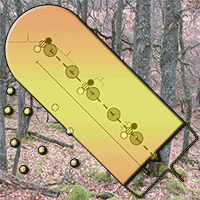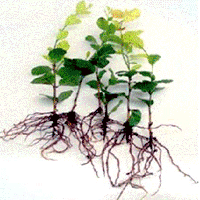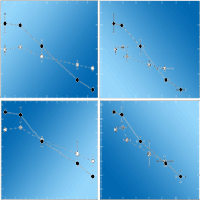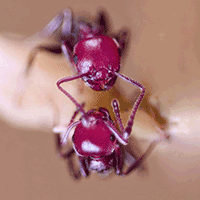
Variability of ant community composition in cork oak woodlands across the Mediterranean region: implications for forest management
Marcello Verdinelli (1) , Salah Eddine Bakkali Yakhlef (2), Carlo Simone Cossu (1), Oriana Pilia (1), Roberto Mannu (1)
iForest - Biogeosciences and Forestry, Volume 10, Issue 4, Pages 707-714 (2017)
doi: https://doi.org/10.3832/ifor2321-010
Published: Jul 27, 2017 - Copyright © 2017 SISEF
Research Articles
Abstract
We evaluated the potential use of ants as a powerful tool for environmental monitoring, together with the applicability of the functional group approach as an alternative method for studying ant communities in cork oak woodlands. Variations in ant community composition, diversity and functional groups were studied in two cork oak forested sites across the Mediterranean region. Ants were sampled using pitfall traps placed along linear transects at 12 sites located in the main cork districts of Italy and Morocco (Gallura in Sardinia, and Maâmora, east of Rabat). A total of 13.501 specimens were collected, belonging to 38 species (five shared species). A distinct separation in the NMDS plots between Gallura and Maâmora ant assemblages was clearly visible. Ant species composition was widely different between the two districts and significant differences were detected within the Gallura district at the species level. Opportunist species were well represented in Gallura (about 27% of average Bray-Curtis similarity) as well as cryptic species (over 23%). In the Maâmora forest, generalized Myrmicinae, hot climate specialists and opportunists contributed equally to the average similarity (together about 53%). Multi-scale ant diversity showed that the true turnover was higher in Gallura than in Maâmora. These findings support the idea that the functional group approach, rather than species diversity per se, could be considered as a valuable tool to detect the response of the ant community to environmental changes in Mediterranean cork oak woodlands. Using ants as bioindicators could help not only in detecting early warning signs of habitat disturbance, but also in defining a useful management strategy to increase the resilience of agroforestry systems under future global change scenarios.
Keywords
Authors’ Info
Authors’ address
Carlo Simone Cossu
Oriana Pilia
Roberto Mannu
Istituto per lo Studio degli Ecosistemi, CNR, Traversa La Crucca 3, 07100 Sassari (Italy)
Division de l’Enseignement Supérieur et de la la Recherche et du Développement, Direction de l’Enseignement, de la Formation et de la Recherche, Station D’bagh - Avenue Hassan II, B.P. 607 Rabat (Morocco)
Corresponding author
Paper Info
Citation
Verdinelli M, Yakhlef SEB, Cossu CS, Pilia O, Mannu R (2017). Variability of ant community composition in cork oak woodlands across the Mediterranean region: implications for forest management. iForest 10: 707-714. - doi: 10.3832/ifor2321-010
Academic Editor
Massimo Faccoli
Paper history
Received: Dec 19, 2016
Accepted: May 12, 2017
First online: Jul 27, 2017
Publication Date: Aug 31, 2017
Publication Time: 2.53 months
Copyright Information
© SISEF - The Italian Society of Silviculture and Forest Ecology 2017
Open Access
This article is distributed under the terms of the Creative Commons Attribution-Non Commercial 4.0 International (https://creativecommons.org/licenses/by-nc/4.0/), which permits unrestricted use, distribution, and reproduction in any medium, provided you give appropriate credit to the original author(s) and the source, provide a link to the Creative Commons license, and indicate if changes were made.
Web Metrics
Breakdown by View Type
Article Usage
Total Article Views: 49932
(from publication date up to now)
Breakdown by View Type
HTML Page Views: 40912
Abstract Page Views: 4013
PDF Downloads: 3753
Citation/Reference Downloads: 21
XML Downloads: 1233
Web Metrics
Days since publication: 3061
Overall contacts: 49932
Avg. contacts per week: 114.19
Citation Metrics
Article Citations
Article citations are based on data periodically collected from the Clarivate Web of Science web site
(last update: Mar 2025)
Total number of cites (since 2017): 16
Average cites per year: 1.78
Publication Metrics
by Dimensions ©
Articles citing this article
List of the papers citing this article based on CrossRef Cited-by.
References
Navigating the multiple meanings of β diversity: a roadmap for the practicing ecologist. Ecology Letters 14: 19-28.
CrossRef | Gscholar
Cork oak woodlands on the edge: conservation, adaptive management, and restoration. Island Press, Washington, DC, USA, pp. 315.
Gscholar
Les fourmis de la forêt de Maâmora (Maroc) [The ants of Maâmora forest (Morocco)]. Revue d’Écologie et de Biologie du Sol 6: 483-513. [In French]
Gscholar
Contribution à la connaissance du Tapinoma simrothi Krausse, fourmi la plus nuisibles aux cultures du Maghreb [Contributions to the knowledge of Tapinoma simrothi Krausse, the most harmful ant in Maghreb crops]. Bulletin de la Société d’Histoire Naturelle de l’Afrique du Nord 67: 87-101. [in French]
Gscholar
Exploring REDD+ opportunities in the Mediterranean - A regional project funded by the French Global Environment Facility (FFEM). Unasylva 65: 56-59.
Gscholar
Économie forestière Nord-Africaine, Tome II, Fascicule I, Monographies et traitements des espèces forestières : le chêne-liège. [Forest Economics of North Africa, Volume II, Fascicule I, Monographs and Treatments of Forest Species: the Cork oak]. Edition Larose, Paris, France, pp. 249. [in French]
Gscholar
The ant fauna of Castelporziano Presidential Reserve (Rome, Italy) as a model for the analysis of ant community structure in relation to environmental variation in Mediterranean ecosystems. Journal of Insect Conservation 14: 585-594.
CrossRef | Gscholar
PRIMER v6. - User manual/tutorial. PRIMER-E Ltd, Plymouth, MA, USA, pp. 192.
Gscholar
Carta dei suoli d’Italia, scala 1:1.000.000 [Soil map of Italy, Scale 1:1.000.000]. Consiglio per la ricerca e la sperimentazione in agricoltura, S.EL.CA, Firenze, Italy. [In Italian]
Gscholar
How to make cork oak forest services visible? Environmental Economics 2: 69-79.
Gscholar
Harmonisation of the soil map of Africa at the continental scale. Geoderma 211-212: 138-153.
CrossRef | Gscholar
World reference base for soil resources 2006. First update 2007. World Soil Resources Reports 103, FAO, Rome, Italy, pp. 128.
Gscholar
Formicidae. In: “Integrated Control of Citrus Pests in the Mediterranean Region” (Vacante V, Gerson U eds). Bentham Science Publishers Ltd, Saif Zone Sharjah, UAE, pp. 231-241.
Gscholar
Dynamique du milieu naturel de la Mamora. Paléoenvironnements et évolution actuelle de la surface [Dynamic of the natural environment of the Maâmora. Paleo-environments and current evolution of the area]. PhD thesis, Université Hassan II, Mohammedia, Rabat, Morocco, pp. 321. [In French]
Gscholar
Statgraphics plus 2001: Statgraphics plus user’s guide vers. 5. Manugistics Inc., Rockville, MD, USA, pp. 730.
Gscholar
An updated list of Sardinian’s ants (Hymenoptera Formicidae). Redia 90: 61-66.
Gscholar
Ant species noxious to cork oak in Sardinia. IOBC/WPRS Bulletin 76: 249-252.
Gscholar
La faune entomologique du chêne-liège en forêt de la Maâmora (Maroc) [The insect fauna of the cork-oak tree in the Mamora forest (Morocco)]. Ecologia Mediterranea 19: 89-98. [in French]
Gscholar

